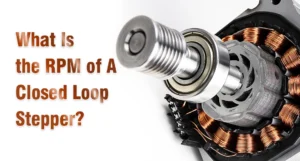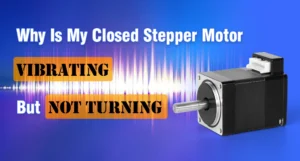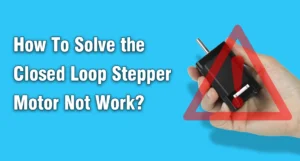Closed-loop stepper motors have revolutionized various industries with their precise control and feedback mechanisms. Understanding the RPM (Revolutions Per Minute) of these motors is crucial for optimizing their performance and efficiency.
What Is The RPM (Revolutions Per Minute)?
Before delving into the specifics of closed-loop stepper motors, it’s essential to grasp the concept of RPM. RPM, or Revolutions Per Minute, is a measure of the rotational speed of a motor. It indicates how many complete revolutions the motor makes in one minute and is a crucial metric in assessing motor performance.
Factors Influencing RPM in Closed Loop Steppers
The RPM of a closed-loop stepper motor is influenced by various factors, including motor design, drive electronics, load characteristics, and the efficiency of the feedback system.
- Motor Design and Specifications
The design and specifications of the motor, such as the number of poles, winding configuration, and torque rating, play a significant role in determining its maximum achievable RPM.
- Drive Electronics
The quality and efficiency of the drive electronics, including the motor drive and controller, directly impact the motor’s speed and responsiveness.
- Load Characteristics
The type and magnitude of the load attached to the motor shaft affect its rotational speed and torque requirements, thereby influencing its RPM. Heavier loads typically result in lower achievable RPM due to increased torque requirements.
- Feedback System
The accuracy and reliability of the feedback system, including the resolution and responsiveness of the encoder or resolver, contribute to the motor’s ability to maintain a consistent RPM.
What RPM Ranges Can Be Expected from Closed Loop Stepper Motors?
The RPM capabilities of closed loop stepper motors can vary widely depending on factors such as motor size, winding configuration, and load characteristics, but typical ranges span from a few hundred to several thousand revolutions per minute.
How to Calculate RPM of a Closed Loop Stepper?
Calculating the RPM of a closed loop stepper motor involves considering factors such as motor step angle, driver micro stepping settings, and pulse frequency. By applying the appropriate formula, it’s possible to determine the motor’s rotational speed accurately.
RPM= (f×60)/ (Step angle×Microstepping)
Where:
f is the frequency of the driver’s pulse train in pulses per second (pps).
Step angle is the angle through which the motor rotates for each step, typically expressed in degrees.
Microstepping is the micro stepping factor, representing the number of micro steps per full step.

Comparison with Open Loop Steppers
Compared to open loop steppers, closed loop steppers offer superior RPM stability and performance in dynamic environments. Open loop steppers rely solely on the input signals and do not provide feedback on the motor’s actual position. In contrast, closed loop steppers use feedback mechanisms to correct errors and maintain consistent RPM, even under varying load conditions.
Data on RPM Ranges
The RPM capabilities of closed loop stepper motors vary depending on their specifications and application requirements. However, typical RPM ranges for closed loop steppers can range from a few hundred to several thousand revolutions per minute, depending on factors such as motor size, winding configuration, and load characteristics.
Advantages of High RPM in Closed Loop Steppers
- Enhanced Speed and Performance
High RPM allows closed loop stepper motors to operate at faster speeds, enabling quicker positioning and improved throughput in various applications.
- Increased Productivity
By achieving higher RPMs, closed loop stepper motors can perform tasks more efficiently, resulting in increased productivity and reduced cycle times.
- Smooth Operation
Maintaining a consistent RPM ensures smooth and precise motion control, minimizing vibrations and reducing the risk of mechanical resonance.
Challenges with RPM in Closed Loop Steppers
- Heating Issues
High RPM operation can lead to increased heat generation in the motor windings, potentially affecting performance and reliability if not adequately managed.
- Torque Reduction
At higher speeds, closed-loop stepper motors may experience a reduction in torque, limiting their ability to handle heavy loads or maintain precise positioning.
- Noise Generation
Increased RPMs can result in higher levels of audible noise, which may be undesirable in noise-sensitive applications or environments.
Methods to Improve RPM Performance
- Efficient Cooling Mechanisms
Implementing effective cooling mechanisms, such as fans or heat sinks, can help dissipate excess heat and prevent overheating at high RPMs.
- Advanced Feedback Systems
Utilizing advanced feedback systems with higher resolution and faster response times can enhance the motor’s ability to maintain precise RPM control.
- Optimal Load Distribution
Properly distributing the load among multiple motors or axes can help reduce the individual motor’s RPM requirements, improving overall system performance.
Future Trends in Closed Loop Stepper Technology
As technology continues to advance, closed loop stepper motors are expected to evolve further, with innovations such as:
Integration with AI and IoT
Miniaturization
Energy Efficiency
Conclusion
The RPM of a closed loop stepper motor is a critical factor in determining its performance and efficiency. By understanding the various factors influencing RPM and implementing appropriate measures to optimize it, users can maximize the capabilities of these advanced motion control systems.
FAQs
Q1: How does RPM affect the performance of closed-loop steppers?
A1: RPM influences the speed, accuracy, and efficiency of closed loop stepper motors, impacting their overall performance in motion control applications.
Q2: Can closed loop stepper motors achieve high RPMs?
A2: Yes, closed loop stepper motors are capable of achieving high RPMs, provided that the motor design, electronics, and feedback system are optimized accordingly.
Q3: How do closed loop stepper motors compare to open loop steppers in terms of RPM stability?
A3: Closed loop stepper motors exhibit better RPM stability and performance in dynamic environments compared to open loop steppers due to their ability to provide real-time feedback and adjust accordingly.





